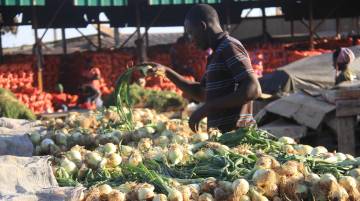
The Sunday Mail

Veronica Gwaze
AFTER 112 years of existence, Mbare, the country’s first high-density suburb, is the busiest and most popular ghetto in Zimbabwe.
Prominent for its early morning hustle and hive of activity, the township is believed to be a place where one can find just about anything — both good and bad.
Despite housing historical markets like the Mbare Musika, Siyaso, Magaba, Stodart Hall, Stodart Netball Complex and Magamba Hall among others, many choose to overlook its success stories to focus on the dark side.
The Zimbabwe Tourism Authority (ZTA) recently embarked on a drive to promote township tourism, with Mbare as their prime target. The township has a huge potential in that regard as it is endowed with a rich history.
According to the book ‘Historic Buildings of Harare (1890-1940)’, the history of Mbare dates back to 1907 when the colonial government — as a way to segregate whites from blacks — established a “native location” about four kilometres from the town centre, on the banks of Mukuvisi River.
Mbare was originally called Harare, a corruption of the Shona word Havarari (they never sleep), a name which Historians say was given to a chief who resided near the Kopje area.
This decision by the colonial regime to move black people from the city gave birth to this historically important suburb.
Since its formation, Mbare has, without doubt, captivated the imaginations of those that pass through or briefly stay in this over-populated and crime-ridden suburb.
Although the majority often paint pictures of the suburb as a present-day Sodom and Gomorrah, a lot of positives can be drawn out of Mbare.
Unlike other high-density suburbs, Mbare took the bold steps of honouring some of its most prominent sons and daughters by naming streets and important buildings after them.
Elizabeth Maria “Mai” Musodzi Ayema (1885–1952) is one of the many prominent people who came out of Mbare and were honoured for their commitment to the development of the suburb. A social worker who fought tenaciously for women’s rights, Mai Musodzi, as Mrs Ayema was fondly called, helped found the Harare African Women’s Club in 1938.
The club helped disadvantaged women and also lobbied for a maternity clinic, which was eventually constructed in the suburb. A recreational hall, the Salisbury Location’s Recreation Hall, was renamed Mai Musodzi Hall in her honour.
Council and social workers, businesspeople and philanthropists who served the suburb with distinction had streets named after them — in honour of their service to the community and to humanity.
Among the individuals that had their names immortalised were Samuel Sondo, Jack Bakasa, Adam Chigwida and Canaan Chipunza. Jack Bakasa Street is a major road which cuts across the Jo’burg Lines section of the suburb. Roads such as Nyazika, Mhlanga and Pazarangu, to name a few, were also named after people who contributed to the development of the sprawling settlement in one way or the other.
Norman Matare, who was born and raised in Mbare, said it is high time the positive things that are associated with this suburb are highlighted.
“I don’t know why Mbare is always portrayed as a place where only evil things happen. Such people pretend to be ignorant about how prominent lawyers, civic leaders, politicians, economists and business people, among others, were nurtured in this suburb.
“We have monumental sites in Mbare and with this move by the ZTA, the township can contribute so much more,” he said.
Prominent people who came out of Mbare are too many to mention. Musicians like Thomas Mapfumo and boxers like former Commonwealth champion Zvenyika Arifonso all trace their roots to Mbare.
Apart from that, Mbare also boasts some of the country’s most iconic institutions such as Harare High School, commonly referred to as paDanho, after the school’s motto “Danho Rashaiwa Makumbo”, meaning the leader of success.
Despite the fact that Harare High is located in the middle of a community grappling with poverty and vices such as crime and prostitution, the school has been churning out students that are shining in their chosen careers. The school has produced thousands of students that have gone on to serve the country with distinction in their respective fields.
The Edith Opperman Maternity Centre has contributed significantly to the reduction of infant mortality and maternal deaths as pregnant women from across the country deliver their babies at the institution.
Another important building which is located in Mbare is the Stodart Hall, a well-known stop-over for national heroes on their way to their final resting places. Stodart Hall is the township’s biggest community centre, which played a pivotal role in the outset of the Second Chimurenga.
Then in 1995 came the commissioning of Stodart Netball Complex, situated opposite Stodart Hall. That year, the complex hosted the African Games (formerly All-Africa Games) and since then, it has become a site of emotional attachment and a campsite for Zimbabwe national netball teams.

Micahel Musekiwa sorting his produce at a vegitable market in Mbare do business as usual disregarding the calls of a stay away which have been circulating on social media.-Picture by Munyaradzi Chamalimba
Rufaro Stadium and the Mbare Musika vegetable market, the country’s biggest fruit and vegetables market, also calls Mbare home.

But Mbare’s narrative will be incomplete if Dynamos Football Club, arguably the most popular club in the country, is not mentioned.
And those that lived or passed through Mbare during the early 1980s up until 2012 often describe, with a nostalgic feeling, how patrons enjoyed themselves in Harare City Council-run beerhalls.
“Back then, we had drinking clubs and we would contribute money and then share opaque beer. With music blaring from Juke Boxes, we would dance till the wee hours, especially on Fridays and during the weekend,” said Mr Francis Yotamu, an elderly resident.
Although the council beer halls had proper, formal names, local residents often referred to them using the most absurd of names, thereby exposing the residents’ creative minds.
Run by Rufaro Marketing, a subsidiary of the Harare City Council, some beerhalls were commonly known by names such as Mapitikoti Bar (petticoats) and Mahovhorosi (overalls)
Rambanai Bar, despite its somewhat inappropriate name, was a popular drinking spot until it was closed in 2012. In Shona, Rambanai is a term which encourages partners to divorce. How locals came up with such an unusual name is anybody’s guess.
According to locals, Mapitikoti Bar got its name from the high numbers of predominantly female patrons that often frequented the bar while Mahovhorosi was a favourite drinking spot for those that were employed in the nearby heavy industrial area. Back then, the majority of those that worked in the industrial areas often wore overalls.
Machembere was a beerhall, which locals say was mostly patronised by the elderly who would have retired. They would often spend the better part of the day imbibing opaque beer and playing a game commonly known as draughts.
Sadly for those that used to frequent the beer halls, the buildings that housed them are either derelict or have been converted to other uses.
Mbare, like the moon, has a dark and bright side.
From the Pioneer Cemetery to World War 2 camps, Mbare has a rich history that many will benefit from through the ZTA township tourism programme.



